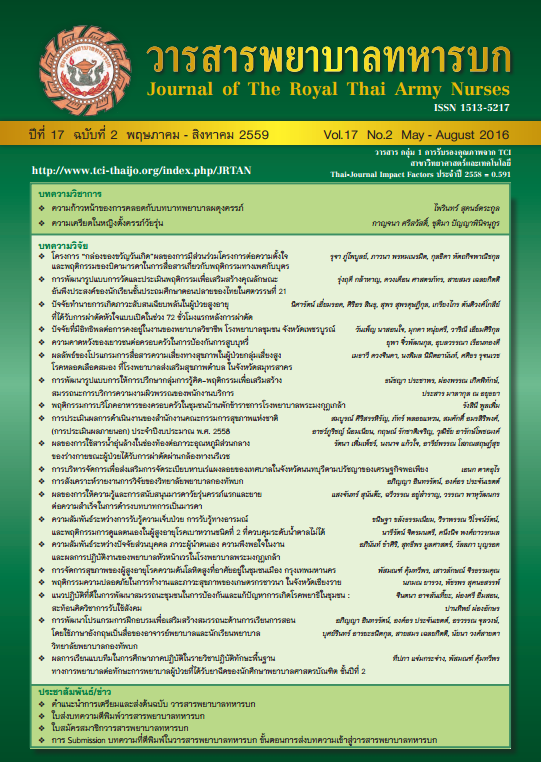พฤติกรรมความปลอดภัยในการทำงานและภาวะสุขภาพ ของเกษตรกรชาวนา ในจังหวัดเชียงราย
Keywords:
พฤติกรรมความปลอดภัยในการทำงาน, ภาวะสุขภาพ, เกษตรกรชาวนา, Occupational Safety, Behaviors Health Status, Rice FarmersAbstract
การวิจัยเชิงพรรณาครั้งนี้ มีวัตถุประสงค์เพื่อศึกษา 1) พฤติกรรมความปลอดภัยในการทำงานและภาวะสุขภาพ2) ความสัมพันธ์ระหว่างพฤติกรรมความปลอดภัยในการทำงานกับภาวะสุขภาพ 3) ความสัมพันธ์ระหว่างพฤติกรรมปกป้องสุขภาพจากการทำงานกับการบาดเจ็บจากการทำงาน และ 4) ความสัมพันธ์ระหว่างพฤติกรรมการใช้สารเคมีกำจัดศัตรูพืชกับผลการตรวจเลือดคัดกรองผู้ที่มีความเสี่ยงจากพิษของสารเคมีกำจัดศัตรูพืช ด้วยการหาเอ็นไซม์โครีนเอสเตอเรสกลุ่มตัวอย่างเป็นเกษตรกรชาวนาในจังหวัดเชียงรายจำนวน 401 ราย เครื่องมือที่ใช้ในการวิจัยเป็นแบบสอบถามประกอบด้วย 3 ส่วน ได้แก่ 1) ข้อมูลส่วนบุคคลและการประกอบอาชีพ 2) พฤติกรรมความปลอดภัยในการทำงาน 3) ภาวะสุขภาพของเกษตรกรชาวนา วิเคราะห์ข้อมูลโดยใช้การแจกแจงความถี่ ร้อยละ ค่าเฉลี่ย ส่วนเบี่ยงเบนมาตรฐาน สถิติสัมประสิทธิ์สหสัมพันธ์แบบสเปียร์แมน และสถิติการทดสอบไคสแควร์ผลการวิจัยพบว่า กลุ่มตัวอย่างส่วนใหญ่ร้อยละ 75.06 มีพฤติกรรมความปลอดภัยในการทำงานอยู่ในระดับปานกลาง[ (S.D.) = 95.95 (6.92)] การรับรู้ภาวะสุขภาพทั่วไปร้อยละ 92.27 อยู่ในระดับปานกลาง [ (S.D.) = 67.62 (8.99)] การตรวจเลือดคัดกรองผู้ที่มีความเสี่ยงจากพิษสารกำจัดศัตรูพืชด้วยการหาเอ็นไซม์โครีนเอสเตอเรสพบว่า มีกลุ่มตัวอย่างร้อยละ 9.98 ร้อยละ 40.65 อยู่ในระดับไม่ปลอดภัย และมีความเสี่ยงพฤติกรรมความปลอดภัยในการทำงานมีความสัมพันธ์ทางบวกกับภาวะสุขภาพ (r = .165, p < .01) พฤติกรรมปกป้องสุขภาพจากการทำงานมีความสัมพันธ์ทางลบกับการบาดเจ็บจากการทำงาน (r = -.104, p < .05) นอกจากนี้พฤติกรรมการใช้สารเคมีกำจัดศัตรูพืชมีความสัมพันธ์กับผลการตรวจเลือดคัดกรองผู้ที่มีความเสี่ยงจากพิษของสารเคมีกำจัดศัตรูพืชด้วยการหาเอ็นไซม์โครีนเอสเตอเรส (p < .05)ผลจากการศึกษานี้ทำให้ทราบถึงปัญหาสุขภาพที่เกิดขึ้นจากการทำงาน โดยเฉพาะการใช้อุปกรณ์ทางการเกษตรและสารเคมีกำจัดศัตรูพืชที่ไม่ถูกต้อง ซึ่งหน่วยงานของรัฐทั้งด้านเกษตรและสาธารณสุขควรให้ความสำคัญและจัดการกับปัญหาที่เกิดขึ้น ก่อนที่จะสูญเสียงบประมาณกับการรักษาจำนวนมากในอนาคต
Occupational Safety Behaviors and Health Status Among Rice Farmers in Chiang Rai Province
The objectives of this descriptive research study were to 1) examine the occupational safety behaviors and health status, 2) determine the relationships among occupational safety behaviors and health status, 3) determine the relationships among health protection behaviors and work injuries, and 4) examine the relationships between pesticide usage and cholinesterase screening test. Convenience sampling was used to recruit 401 rice farmers into the study. Research instrument consisted of 3 parts : 1) individual and working characteristics 2) occupational safety behaviors 3) health status. Data were analyzed by using frequency, percentage, mean, standard deviation, Spearman rank correlation coefficiency and chi-square test Majority of the participants (75.06%) has occupational safety behaviors at a moderate level [ (S.D.) = 95.95 (6.92)]. In terms of general health perception it was found that 92.27 percent of participants at a moderate [ (S.D.) = 67.62 (8.99)]. The results of screening blood tests for cholinesterase were found to be
9.98%, 40.65% of participants operating in levels of insecurity and risk. The relationship between occupational safety behaviors and health status was significantly positive statistically (r = .165, p <.01) while there was a negative correlation between the health protection behavior at work and injuries from work (r = -.104, p <.05). Furthermore, a significant correlation between pesticide usage and the results of cholinesterase screening test was revealed (p <.05). Health problems may arise from work, especially the use of agricultural equipment and pesticides improperly.The Ministry of Agriculture and The Ministry of Health should be alert and fix the problems. Oterwise may spend a lot of money for the treatments in the future.
Downloads
Downloads
How to Cite
Issue
Section
License
บทความหรือข้อคิดเห็นใดใดที่ปรากฏในวารสารพยาบาลทหารบกเป็นวรรณกรรมของผู้เขียน ซึ่งบรรณาธิการหรือสมาคมพยาบาลทหารบก ไม่จำเป็นต้องเห็นด้วย
บทความที่ได้รับการตีพิมพ์เป็นลิขสิทธิ์ของวารสารพยาบาลทหารบก
The ideas and opinions expressed in the Journal of The Royal Thai Army Nurses are those of the authors and not necessarily those
of the editor or Royal Thai Army Nurses Association.






